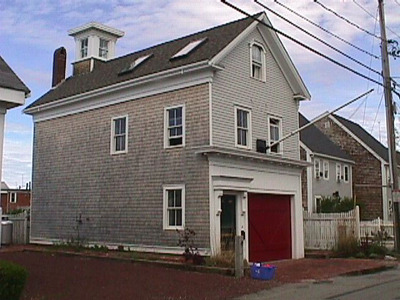117 Commercial St
Historic District Survey information for 117 Commercial St | |
Architectural Description: 117 Commercial St. is a 2-1/2-story; 2-bay Italianate-style former fire house; gable-front roof is sheathed in asphalt shingles, rear exterior brick chimney with arched cap, partial cornice returns, modern skylights; exterior is clad in clapboard on 2nd story of front facade and wood shingles on the other facades, wood corner boards, 1st story of front facade comprised of wood surround including pent roof with entablature and dentils, building sits on a concrete block foundation; fenestration includes single 2/2 vinyl DHS windows, segmental arched trim over front gable-end attic window; primary entrance is accessed by a pane-and-panel wood door with a wood entablature surround and flat brackets; wood ledged and braced overhead garage door; square cupola on rear roof ridge with dentiled cornice is lit by 2/2 vinyl DHS windows. |
|
Historical Narrative: As per Josephine Del Deo (1976): "The firehouses in Provincetown are a significant part of the community development. They house the pumpers for each section of the town and all fire fighting equipment. NI additional they were important social gathering places for the volunteers of the fire department. Which is an old and distinguished organization of the town dating back to 1836 (see Jennings) Many of the original memorabilia of each of the five pumper houses is now displayed at the Provincetown Heritage Museum. The location of the old engines still held by the town: 'Ulysses' Pumper #3, by Adams Pharmacy; 'Franklin' No. 2 Provincetown Heritage Museum, 'Washington', Pilgrim Monument Museum. 'Old Steamer' now owned by Edaville Railroad. The meetings and drills general social life of the fire department is carried on in the firehouses today just as it was in the beginning days of the companies and is therefore significant as a social legacy completely unchanged."
As per Tom Boland (1994): "On March 7, 1835 the Fire Department was created through a vote of town meeting. In 1850, another engine was purchased and established in the former firehouse at 351 Commercial Street. In May of 1859, A Board of Engineers was formed to expand the Department and oversee the acquisition of more equipment and the construction of five new stations. The first fire chief was E.G. Loring. The dates of these equipment purchases were: No. 1 (117 Commercial) 1868, No. 4 (189 Commercial) 1868, No. 5 (514 Commercial) 1869, No. 2 (252 Commercial) 1871. All of these firehouses were built in the same style and are quite similar. Number 117 Commercial Street, then called Engine #2, was the repository for the Franklin Engine, a 5 1/2 cylinder 16 stroke engine, built by the Messrs. Hunneman & Co. of Boston Highlands. The house was erected at a cost of $1200. The house is currently called Engine 1.In 1993 the Fire Department suspended operation in all the stations (except #3, a slightly later station which houses an ambulance, and #5 which houses an antique engine) and centralized equipment at the new Shank Painter Fire House. |
|
Bibliography and/or References: Barnstable County Atlas., 1880.
Barnstable County Atlas., 1907.
Cape Cod Directory, 1901.
The Extremity of Cape Cod. Map, 1836.
H.F. Wallings Co. Map of Provincetown Village. Atlas, 1858.
Jennings, Herman A. Chequocket or Provincetown. 1893.
Jennings, Herman A. Provincetown. or Odds and Ends from the Tip End. 1890.
Report of Town Officers. 1870, 1872. Provincetown.
Resident Directory. W.F. Richardson & Co., 1886.
Resident Directory. W.H. Hopkins, 1889.
Hatch C. and Mellen C. M. "The Log of the Provincetown and Truro on Cape Code, Massachusetts, pp 45-46 |
|
Text |
|
Commercial Street (Provincetown, Mass.), Dwellings, and Historic Districts--Massachusetts--Provincetown |
|
Comments (0)
NOTICE: It appears you do not have Javascript enabled in your Web browser. To access some of the features on the site (including email links) you must enable Javascript and refresh the page.



There are no comments for this archive.